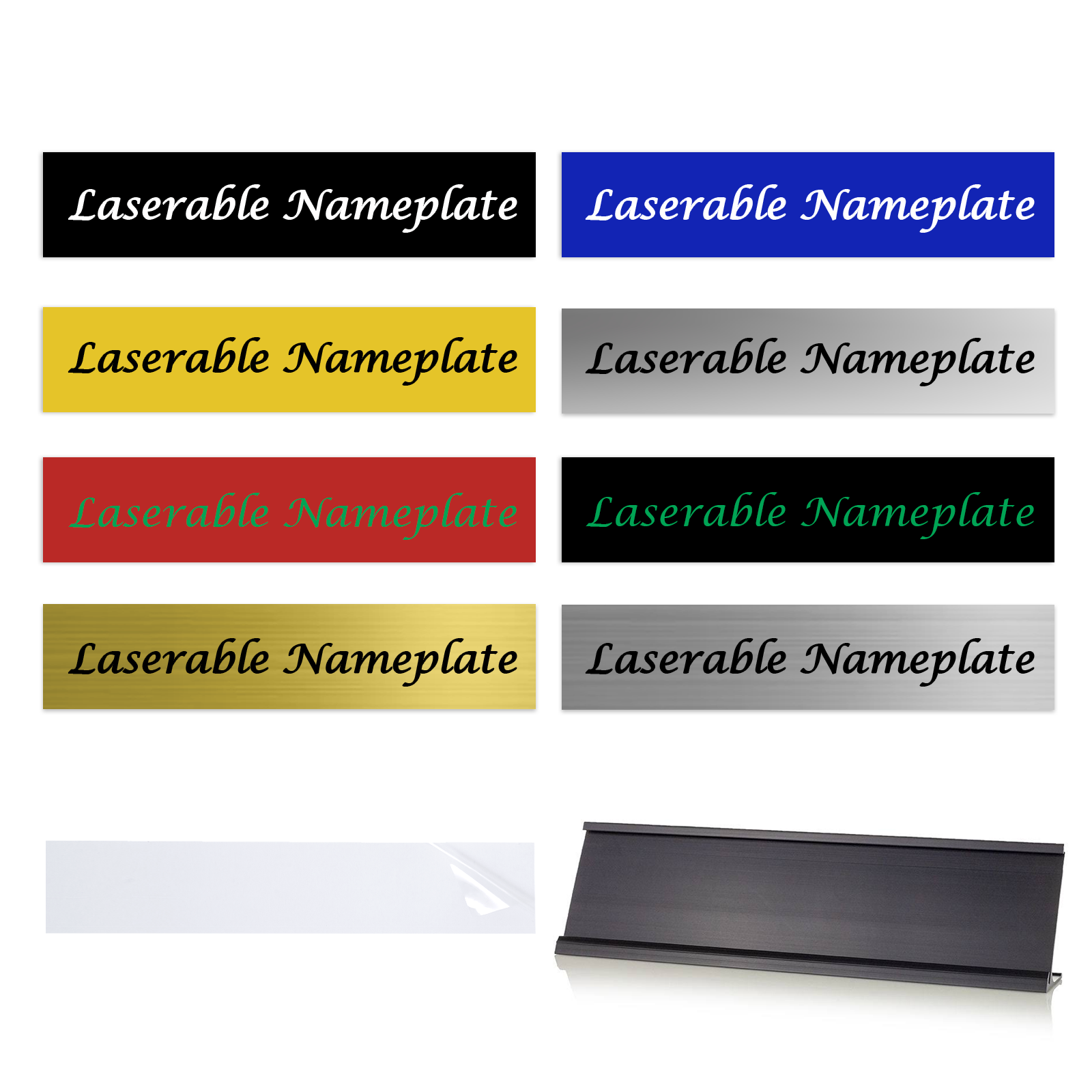Plastic Nameplates and OSHA Compliance: What You Should Know
Understanding Exactly How Plastic Nameplates Job: Insights Into Their Performance and Advantages
Plastic nameplates are necessary tools for recognition and communication in numerous settings. Constructed from resilient materials like acrylic and PVC, they offer both strength and visual charm. Various printing techniques enhance their presence and branding prospective. Understanding their capability discloses not just their sensible applications but likewise the benefits they offer organizations. As markets advance, the function of plastic nameplates may shift, motivating a more detailed take a look at their recurring relevance and technology.
The Products Behind Plastic Nameplates
Plastic nameplates are crafted from a variety of products, each chosen for its one-of-a-kind residential properties and suitability for various applications. Typical products include acrylic, polycarbonate, and PVC, each offering distinct benefits. Polymer is preferred for its quality and lightweight nature, making it suitable for interior usage and display purposes. Polycarbonate, known for its high influence resistance, is frequently chosen for atmospheres where longevity is essential (Plastic Nameplates). PVC, on the other hand, provides an economical option with suitable weather resistance, ideal for outdoor applications.Additionally, the choice of product can influence variables such as color retention, simplicity of printing, and general visual allure. This option process guarantees that the last product satisfies certain needs, whether for branding, identification, or decorative purposes. Understanding the residential properties of these products helps in making notified choices when choosing plastic nameplates for various demands
Production Processes of Plastic Nameplates
The manufacturing processes of plastic nameplates encompass numerous essential actions that guarantee quality and sturdiness. Trick aspects consist of product selection methods, various printing approaches, and ending up and finishing choices. Comprehending these components is crucial for generating effective and cosmetically pleasing nameplates.
Product Option Strategies
Selecting the right products for manufacturing plastic nameplates is crucial for guaranteeing sturdiness, aesthetic appeal, and functionality. Numerous plastic types are offered, each offering unique homes matched for different applications. Polyvinyl chloride (PVC) is prominent for its price and resistance to ecological elements, making it ideal for exterior usage. Acrylonitrile butadiene styrene (ABDOMINAL) provides boosted impact resistance and is often selected for its premium strength and adaptability. Furthermore, polycarbonate is favored for applications needing openness and high impact resistance. The option process involves considering variables such as the meant use, environmental direct exposure, and preferred aesthetic qualities. Eventually, cautious product option significantly affects the efficiency and long life of plastic nameplates, satisfying diverse sector requirements.
Printing Methods Overview
Product selection lays the foundation for the succeeding printing methods used in generating plastic nameplates. Various techniques, such as screen printing, electronic printing, and pad printing, are used to achieve high-quality designs and durable finishes. Display printing is preferred for its capability to create dynamic shades and appropriates for huge runs. Digital printing, on the various other hand, supplies adaptability and accuracy, making it perfect for smaller orders with variable information or complex layouts. Pad printing enables the transfer of photos onto irregular surfaces, accommodating complicated shapes. Each printing method contributes distinctively to the last item's appearance and durability, guaranteeing that the nameplates properly convey the intended message and endure ecological factors.
Finishing and Finishing Options
Completing and finish alternatives play a vital duty in boosting the durability and aesthetic charm of plastic nameplates. Different strategies, such as UV finishing, provide a safety layer that withstands scrapes and fading, considerably prolonging the item's lifespan. Additionally, laminating alternatives can use a shiny or matte surface, enabling personalization to match branding requirements. Electroplating and plating are also popular techniques, adding a metallic sheen while improving rust resistance. These coverings not only boost appearance but additionally add to the nameplate's capability by protecting against environmental elements. Specialized surfaces, such as anti-graffiti finishes, warranty that nameplates preserve their legibility and aesthetic charm in tough conditions. The right ending up and coating choices can substantially boost the overall worth of plastic nameplates.
Design Options for Customization
While exploring style alternatives for customization, one discovers a broad selection of possibilities that can enhance the practical and aesthetic appeal of plastic nameplates. Shade choice is a main consideration, as lively colors can bring in focus while neutral tones advertise expertise. Various font style options and dimensions in addition customize nameplates, making sure readability and positioning with brand identity.Incorporating logo designs or images includes a distinct touch, enhancing organizational branding. Form personalization permits for unique layouts, ranging from basic rectangles to much more elaborate forms, providing to certain styles or environments.Textures such as matte or shiny surfaces can likewise influence the overall appearance, providing a responsive measurement. On top of that, the assimilation of decorative elements like backgrounds or boundaries enhances aesthetic passion. These personalization options collectively allow organizations to develop plastic nameplates that properly communicate their identification and message while meeting useful demands.

Resilience and Longevity of Plastic Nameplates
Although several aspects influence the durability of plastic nameplates, the choice of product and manufacturing procedures plays a considerable function in their long life. Premium plastics, such as polycarbonate and acrylic, are commonly chosen for their inherent resistance to climate, uv, and effect radiation. These products can withstand extreme ecological conditions without considerable destruction, assuring that nameplates remain undamaged over time.Furthermore, progressed production methods, such as injection molding and laser engraving, add to the effectiveness of plastic nameplates. These processes develop accurate and long lasting engravings that resist fading and wear. Additionally, safety layers may be used to enhance resistance to chemicals and scrapes, better prolonging their lifespan.Ultimately, the combination of quality materials and efficient production procedures assures that plastic nameplates maintain their capability and look for years, making them a reliable option for different applications.
Applications Throughout Different Industries
Plastic nameplates offer a selection of essential functions across different markets. They are frequently utilized for industrial tools recognition, making sure clear labeling for safety and security and functional effectiveness. In addition, they give reliable workplace signs services and play an important duty in security and conformity markings, highlighting their flexibility and relevance in diverse atmospheres.
Industrial Tools Recognition
Reliable commercial devices identification is crucial across numerous fields, as it assures safety and security, effectiveness, and compliance with governing standards. Plastic nameplates act as a vital device in this procedure, providing clear and sturdy identification for equipment and tools. Industries such as production, building and construction, and power use these nameplates to display essential details, consisting of operating guidelines, hazard warnings, and upkeep timetables. Their durability to rough atmospheres warranties that necessary data continues to be easily accessible, decreasing the threat of mishaps and functional downtime. Furthermore, personalized functions permit branding and particular classifying needs, making plastic nameplates flexible across applications. Overall, effective equipment recognition through plastic nameplates fosters a safer workplace while boosting performance in diverse industrial settings.
Office Signs Solutions

In numerous markets, the importance of clear interaction extends beyond industrial devices to office atmospheres where signs plays a vital role. Plastic nameplates work as effective office signage options, supplying crucial details such as staff member names, work titles, and department classifications. These nameplates boost professionalism and trust and cultivate a welcoming environment, helping both team and site visitors in maneuvering the work area. In addition, they offer modification choices, enabling services to line up signage with branding and visual preferences. In setups like hospitals, educational institutions, and corporate workplaces, clear and long lasting signage guarantees reliable interaction and adds to business performance. Ultimately, the usage of plastic nameplates in office atmospheres not just boosts clearness however additionally advertises a orderly and natural workspace.
Safety and Compliance Markings
While numerous businesses focus on looks and branding in their signage, safety and security and conformity markings are similarly necessary across numerous markets. These markings function as important devices for communication, ensuring that consumers and workers are aware of prospective dangers, safety and security procedures, and governing demands. In production, for example, plastic nameplates often show advising tags and use directions to alleviate threats. In medical care, compliance signs educates personnel regarding health additional hints techniques and tools usage, consequently advertising a safe atmosphere. Furthermore, the durability of plastic nameplates makes them appropriate for different settings, standing up to damage from environmental aspects. Overall, safety and conformity markings boost operational effectiveness, promote wellness, and warranty adherence to sector standards, making them crucial in contemporary workplaces.
Advantages of Utilizing Plastic Nameplates
Countless advantages make plastic nameplates an attractive option for companies and organizations. this page One primary benefit is their durability; plastic nameplates are immune to fading, moisture, and different environmental aspects, guaranteeing long life in varied setups. Furthermore, they are lightweight, making them easy to set up and move as needed.Cost-effectiveness is another substantial advantage. Plastic nameplates commonly need reduced manufacturing costs contrasted to steel or wood alternatives, allowing companies to keep spending plans while achieving specialist branding. Their convenience additionally sticks out, as they can be personalized in different shapes, dimensions, and colors to match branding requirements.Furthermore, plastic nameplates can be conveniently printed with high-resolution styles, advertising clear visibility and efficient interaction. They are usually made from recyclable materials, aligning with eco conscious techniques. These consolidated advantages improve the functionality and appeal of plastic nameplates for a series of applications in different markets.

Tips for Selecting the Right Nameplate for Your Demands
Picking the appropriate nameplate can greatly enhance an organization's branding and communication initiatives. To make an informed choice, one have to first think about the product. Plastic nameplates offer resilience and versatility, making them excellent for various settings. Next off, evaluate the style aspects, consisting of size, shade, and font design, ensuring they straighten with the company's branding guidelines.Additionally, it is crucial to examine the intended use the nameplate. For instance, if it needs to hold up against exterior conditions, selecting UV-resistant alternatives is recommended. Modification is an additional vital aspect; personalized nameplates can reflect individuality and professionalism.Lastly, budget considerations must not be ignored. Contrasting prices across various distributors while considering quality will certainly assist in finding an appropriate service. By taking these aspects into account, companies can select a nameplate that successfully communicates their identity and objective.
Frequently Asked Concerns
Can Plastic Nameplates Be Recycled After Usage?
Plastic nameplates can be recycled, depending on the kind of plastic utilized and neighborhood recycling facilities. Proper disposal and reusing techniques add to ecological sustainability, motivating the reduction of plastic waste in land fills.
Just how Do I Tidy and Keep My Plastic Nameplate?

Are Plastic Nameplates Waterproof or Water-Resistant?
Plastic nameplates normally show water-resistant residential or commercial properties, shielding them from small moisture direct exposure. Nonetheless, long term submersion or extreme conditions may compromise their integrity. Plastic Nameplates. Users must consider specific materials and layers for improved water-proof capacities when selecting nameplates
What Is the Average Life Expectancy of a Plastic Nameplate?
The average life-span of a plastic nameplate commonly ranges from 5 to 10 years, depending upon factors such as environmental exposure, material quality, and maintenance. Normal care can expand its functionality and appearance substantially.
Can I Order a Nameplate in a Certain Shape?
Personalized form choices for nameplates are usually readily available via different makers. Clients can ask for particular designs, ensuring that the nameplate satisfies their functional and aesthetic requirements while maintaining durability and quality throughout its life expectancy. Product selection lays the groundwork for the subsequent printing methods made use of in producing plastic nameplates. Lots of factors influence the sturdiness of plastic nameplates, the selection of material and production processes plays a considerable duty in their durability. These products can withstand severe ecological conditions without substantial deterioration, guaranteeing that nameplates continue to be intact over time.Furthermore, progressed manufacturing strategies, such as injection molding and laser inscription, contribute to the robustness of plastic nameplates. Plastic nameplates can be reused, depending on the type of plastic made use of and regional recycling centers. The typical life-span of a plastic nameplate generally ranges from five to 10 years, depending on aspects such as environmental exposure, worldly high quality, and maintenance.